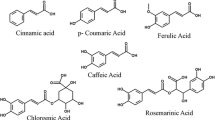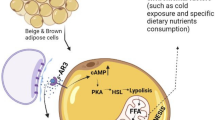Abstract
Propolis is known to have multiple biological and pharmacological properties including the regulation of energy homeostasis. Although phenolic compounds are considered to be the major active components in propolis, there is little information available about their mechanisms underlying the regulation of energy homeostasis. In this study, the effects of five phenolic compounds in propolis, chrysin, pinocembrin, galangin, pinobanksin, and caffeic acid phenethyl ester (CAPE) were evaluated on the activation of free fatty acid receptor 4 (FFA4), which are involved in the control of energy homeostasis by enhancing insulin signaling, increasing glucose uptake, and regulating adipogenesis. The results showed that three phenolic compounds exhibited the activation of FFA4, which were ranked in the order of pinocembrin, CAPE and pinobanksin in FFA4-expressing cells. These results suggest that some phenolic compounds in propolis, particularly pinocembrin, may affect the control of energy homeostasis via the activation of FFA4.


Similar content being viewed by others
References
Ahad A, Ganai AA, Mujeeb M, Siddiqui WA. Chrysin, an anti-inflammatory molecule, abrogates renal dysfunction in type 2 diabetic rats. Toxicol. Appl. Pharmacol. 279: 1-7 (2014)
Akyol S, Ozturk G, Ginis Z, Armutcu F, Yigitoglu MR. In vivo and in vitro antineoplastic actions of caffeic acid phenethyl ester (CAPE): therapeutic perspectives. Nutr. Cancer 65: 515-526 (2013)
Auguste S, Fisette A, Fernandes MF, Hryhorczuk C, Poitout V, Alquier T, Fulton S. Central agonism of GPR120 acutely inhibits food intake and food reward and chronically suppresses anxiety-like behavior in mice. Int. J. Neuropsychopharmacol. 19: 1-10 (2016)
Burdock G. Review of the biological properties and toxicity of bee propolis (propolis). Food Chem. Toxicol. 36: 347-363 (1998)
Celik S, Erdogan S, Tuzcu M. Caffeic acid phenethyl ester (CAPE) exhibits significant potential as an antidiabetic and liver-protective agent in streptozotocin-induced diabetic rats. Pharmacol. Res. 60: 270-276 (2009).
Choi MJ, Lee EJ, Park JS, Kim SN, Park EM, Kim HS. Anti-inflammatory mechanism of galangin in lipopolysaccharide-stimulated microglia: Critical role of PPAR-γ signaling pathway. Biochem. Pharmacol. 144: 120-131 (2017)
Depoortere I. Taste receptors in the gut tune the release of peptides in response to nutrients. Peptides 66: 9-12 (2015)
Fuliang HU, Hepburn HR, Xuan H, Chen M, Daya S, Radloff SE. Effects of propolis on blood glucose, blood lipid and free radicals in rats with diabetes mellitus. Pharmacol. Res. 51: 147-152 (2005)
Giri SS, Sen SS, Sukumaran V, Park SC. Pinocembrin attenuates lipopolysaccharide-induced inflammatory responses in Labeo rohita macrophages via the suppression of the NF-κB signalling pathway. Fish Shellfish Immunol. 56: 459-466 (2016)
Granados-Pineda J, Uribe-Uribe N, García-López P, Ramos-Godinez M, Rivero-Cruz J, Pérez-Rojas J. Effect of Pinocembrin Isolated from Mexican Brown Propolis on Diabetic Nephropathy. Molecules 23: 852 (2018)
Hara T, Kashihara D, Ichimura A, Kimura I, Tsujimoto G, Hirasawa A. Role of free fatty acid receptors in the regulation of energy metabolism. Biochim Biophys Acta Mol. Cell Biol. Lipids 1841: 1292-1300 (2014)
Hassan NA, El-Bassossy HM, Mahmoud MF, Fahmy A. Caffeic acid phenethyl ester, a 5-lipoxygenase enzyme inhibitor, alleviates diabetic atherosclerotic manifestations: effect on vascular reactivity and stiffness. Chem-Biol. Interact. 213: 28-36 (2014)
Huang S, Zhang CP, Wang K, Li GQ, Hu FL. Recent advances in the chemical composition of propolis. Molecules 19: 19610-19632 (2014)
Im DS. FFA4 (GPR120) as a fatty acid sensor involved in appetite control, insulin sensitivity and inflammation regulation. Mol. Aspects Med. 64: 92-108 (2018).
Kasiotis KM, Anastasiadou P, Papadopoulos A, Machera K. Revisiting Greek propolis: chromatographic analysis and antioxidant activity study. PloS One 12: e0170077 (2017)
Kim K, Park M, Lee YM, Rhyu MR, Kim HY. Ginsenoside metabolite compound K stimulates glucagon-like peptide-1 secretion in NCI-H716 cells via bile acid receptor activation. Arch. Pharmacal. Res. 37: 1193-1200 (2014)
Kitamura H, Naoe Y, Kimura S, Miyamoto T, Okamoto S, Toda C, Shimamoto Y, Iwanaga T, Miyoshi I. Beneficial effects of Brazilian propolis on type 2 diabetes in ob/ob mice: Possible involvement of immune cells in mesenteric adipose tissue. Adipocyte 2: 227-236 (2013)
Kumar S, Alagawadi KR. Anti-obesity effects of galangin, a pancreatic lipase inhibitor in cafeteria diet fed female rats. Pharm. Biol. 51: 607-613 (2013)
Lee JY, Park W. Anti-inflammatory effect of chrysin on RAW 264.7 mouse macrophages induced with polyinosinic-polycytidylic acid. Biotechnol. Bioprocess Eng. 20: 1026-1034 (2015)
Li H, Wu F, Tan J, Wang, K, Zhang C, Zheng H, Hu F. Caffeic acid phenethyl ester exhibiting distinctive binding interaction with human serum albumin implies the pharmacokinetic basis of propolis bioactive compounds. J. Pharm. Biomed. Anal. 122: 21-28 (2016)
Liu HD, Wang WB, Xu ZG, Liu CH, He DF, Du LP, Li MY, Yu X, Sun JP. FFA4 receptor (GPR120): A hot target for the development of anti-diabetic therapies. Eur. J. Pharmacol. 763: 160-168 (2015)
Mani R, Natesan V. Chrysin: Sources, beneficial pharmacological activities, and molecular mechanism of action. Phytochemistry 145: 187-196 (2018)
Moniri NH. Free-fatty acid receptor-4 (GPR120): Cellular and molecular function and its role in metabolic disorders. Biochem. Pharmacol. 110: 1-15 (2016)
Nakajima M, Arimatsu K, Minagawa T, Matsuda Y, Sato K, Takahashi N, Nakajima T, Yamazaki K. Brazilian propolis mitigates impaired glucose and lipid metabolism in experimental periodontitis in mice. BMC Complementary Altern. Med. 16: 329 (2016)
Nakajima S, Hira T, Yahagi A, Nishiyama C, Yamashita T, Imagi J, Hara H. Unsaturated aldehydes induce CCK secretion via TRPA1 in STC‐1 cells. Mol. Nutr. Food Res. 58: 1042-1051 (2014).
Pei B, Sun J. Pinocembrin alleviates cognition deficits by inhibiting inflammation in diabetic mice. J. Neuroimmunol. 314: 42-49 (2018)
Sang H, Yuan N, Yao S, Li F, Wang J, Fang Y, Qin S. Inhibitory effect of the combination therapy of simvastatin and pinocembrin on atherosclerosis in apoE-deficient mice. Lipids Health Dis. 11: 166 (2012)
Sivakumar AS, Viswanathan P, Anuradha CV. Dose-dependent effect of galangin on fructose-mediated insulin resistance and oxidative events in rat kidney. Redox Rep. 15: 224-232 (2010)
Zhou LT, Wang KJ, Li L, Li H, Geng M. Pinocembrin inhibits lipopolysaccharide-induced inflammatory mediators production in BV2 microglial cells through suppression of PI3K/Akt/NF-κB pathway. Eur. J. Pharmacol. 761: 211-216 (2015)
Acknowledgements
This work was supported by a Grant from Small Grant for Exploratory Research of Basic Science Research Program through the National Research Foundation of Korea (NRF) funded by the Ministry of Education (Grant No. 2016R1D1A1A02937328).
Author information
Authors and Affiliations
Corresponding author
Ethics declarations
Conflict of interest
The authors declare no conflict of interest.
Additional information
Publisher's Note
Springer Nature remains neutral with regard to jurisdictional claims in published maps and institutional affiliations.
Rights and permissions
About this article
Cite this article
Cho, H., Kim, K., Kim, N. et al. Effect of propolis phenolic compounds on free fatty acid receptor 4 activation. Food Sci Biotechnol 29, 579–584 (2020). https://doi.org/10.1007/s10068-019-00688-4
Received:
Revised:
Accepted:
Published:
Issue Date:
DOI: https://doi.org/10.1007/s10068-019-00688-4




